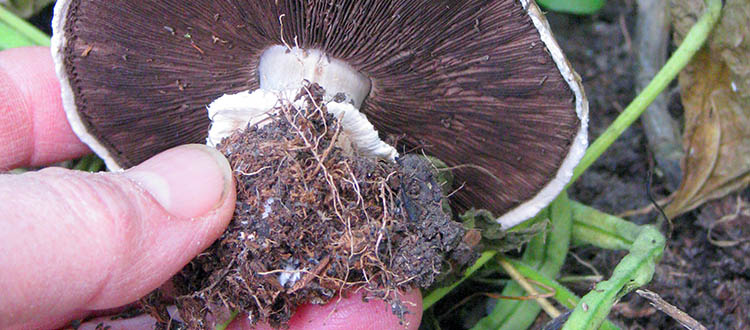
Oct. 18, 2016 | Donna Balzer
Can I take your order?
If your yard is a bar, mushrooms are the patrons and the wait staff The phone call came during my regular CBC radio phone-in show.
The phone call came during my regular CBC radio phone-in show.The caller had heard Dr. Scholl's foot powder was a fungicide. She knew lawn mushrooms were a type of fungus, so she wondered if she could kill her lawn mushrooms with foot powder – active ingredient Tolfanate, a synthetic thiocarbamate.
"No, definitely not," I exclaimed.
If your yard is a bar, mushrooms are not just furniture. They are the patrons and the servers in your yard bar. They drink in the sugars and pass around the snacks.
The Extreme Science blog confirms it is a really big bar: "(The) most recent large-scale mushroom was estimated to cover over 2,200 acres (890 hectares)."
I am not saying my caller's mushroom was part of the biggest mushroom patch ever found. Yet I am saying a mushroom never stands alone. It has a big root-like mass called mycelium (plural mycelia.) As the mycelia grows, it slurps sugars shared by your trees, in your yard. A healthy soil is packed with mushroom mycelia and, if conditions are right for breeding, a mushroom pops up to the surface.
As it turns out, mushrooms don't just drink up the sugar, either. They help trees help each other.
Dying Trees Can Send Food to Neighbor's of Different Species, a blog article by Jennifer Frazer in the Artful Amoeba explains that trees use mushrooms to share nutrients among trees.
"Forest trees and their root fungi are more or less a commune in which they share resources in a fashion so unabashedly socialist that I hesitate to describe it in detail," writes Frazer.
"[Mushrooms] bond trees so intimately that the more you learn about them, the more it is a struggle to view any tree as an individual."
Fraser explains, for example, that mushroom mycelia move phosphorus and nitrogen from dying to living trees, even if the trees are of different kinds.
A mushroom found on a lawn (and who hasn't found at least one this fall?) is connected to trees and shrubs through its mycelia, which either grows inside or on top of tree root hairs. The co-operative trees share 20 to 80 per cent of the sugars they make during photosynthesis in exchange for the minerals mushrooms find in the soil or bring over from dying trees.
If you have mushrooms, that is a good thing. It means your yard is connected to other yards through the comingling of tree roots.
It seems obvious to me that harming either the tree or mushroom with a product meant to keep our feet clean and dry is not a good idea. Would you poison the communal soup pot just because you don't like some of the people in your commune?
Probably not. So why poison the food transport system or mushrooms on your lawn?
Instead, let's start celebrating all organisms and their efforts to work together to make our world a better place. While the trees share the sugar, the mushrooms work as their patron and their wait staff in the soil food bar of life.
Donna Balzer is an enthusiastic gardener and entertaining speaker. Sign up for her e-newsletter at www.gardenguru.net or follow her on Twitter @NoGuffGardener.
Tagged: advice | backyard | Calgary Real Estate | Calgary Real Estate News | flowers | front yard | Gardening | Guest Column | lawn | tips | trees | YYCRE




